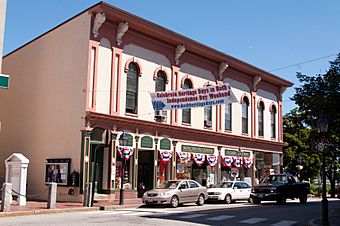Bath Historic District (Bath, Maine) facts for kids
Quick facts for kids |
|
|
Bath Historic District
|
|

Downtown Bath
|
|
| Location | Roughly bounded by High, Beacon, and Court Sts., U.S. 1 and Kennebec River, Bath, Maine |
|---|---|
| Area | 300 acres (120 ha) |
| Architectural style | Mid 19th Century Revival, Late Victorian |
| NRHP reference No. | 73000261 |
| Added to NRHP | May 17, 1973 |
The Bath Historic District is a special area in Bath, Maine. It includes the old business part of town from the 1800s and a nearby neighborhood. Bath is famous for building ships, and it has been a top shipbuilding city for a long time. This historic district was added to the National Register of Historic Places in 1973. This means it's an important place to protect because of its history.
Contents
Bath's Rich History: A Shipbuilding City
The area that is now Bath was first settled by Europeans in the mid-1600s. People quickly saw it was a perfect place to build ships. The city is located along a part of the lower Kennebec River. This section was called "Long Reach" because ships could sail there easily without changing their sails.
How Bath Became a City
The town officially became "Bath" in 1781. It was named after Bath, England. During the 1800s, the city grew on the west side of the river. Shipyards lined the riverbanks, making Bath a busy place.
Changes in Shipbuilding
Over time, new types of ships were built, like those made of steel. This change caused some challenges for Bath's shipbuilding industry. However, in 1889, the Bath Iron Works was started. This company became very successful, especially by building ships for the United States Navy. This success helped the local economy stay strong. Today, Bath Iron Works is the city's only shipyard.
Exploring the Historic District
The Bath Historic District covers about 300 acres. It has clear boundaries:
- To the south: U.S. Route 1 and Centre Street
- To the west: High Street
- To the north: Beacon Street
- To the east: The Kennebec River
Key Buildings in Downtown Bath
The downtown area is in the southeastern part of the district. Here you can find beautiful buildings from the mid-1800s. Some important ones include:
- The former United States Customhouse and Post Office: This building was designed by Ammi B. Young and built between 1853 and 1858.
- The Sagadahoc County Courthouse: Built in 1869, this courthouse was designed by Portland architect Francis H. Fassett.
- The Church Block: This building, built in 1863, shows off the Italianate style of architecture.
Historic Homes and Architecture
As you move north and west from downtown, you'll find residential areas. These neighborhoods have many lovely homes. They are great examples of Italianate and Greek Revival architecture. These styles were popular in the 1800s.



